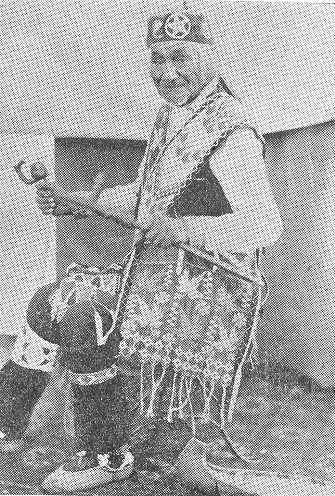|

Med-we-a-sing, Chippewa Indian Leader in Formal Costume
I
have been following with much interest the series of articles on the Sioux-Chippewa
feud. It has occurred to me that your readers might also be interested
in the old headmen of the tribe with whom I came in contact some years
ago. I am furnishing you with these notes a picture given me by this old
Indian some 30 years ago.
For
many years he was the head of his band and was a very remarkable character.
He lived at the Lac du Flambeau village in Vilas County. He was about
one hundred years old when he gave me that picture which was about thirty
years ago. I have been told that he lived to be 106 years of age. He visited
Eau Claire and other points on the Chippewa when he was a young mane,
and he told me that he visited Washington, D.C., five times to talk with
the 'Great Father' about treaties. The last visit there was to talk about
allotments of 80 acres each, to the Chippewa Indians instead of holding
the reservation as tribal land.
The
Indians usually selected fine timberlands from which they sold the stumpage
to contractors. Henry and Leonard bought the standing timber on Med-we-a-sing's
and his son-in-law's eighties, logged the same, and sold the logs to the
Chippewa Logging Company (the so-called Pool).
We
advanced the cost of a house for the two families to live in, and furnish
them with provisions, clothing and everything to make them comfortable
in their new home. Med-we-a-sing did not want to be the first of the headmen
of the tribe to enter into a contract for his timber, so we advanced him
money as above stated, until the chiefs of the tribe had sold their timber.
When the other headmen had entered into contract, Med-we-a-sing, who was
known to be an honest man, sent for me to bring the paper (contract),
that he was ready to close the verbal deal with us.
The
house was so constructed that the two Indians families lived on the first
floor, the upper story was used as a Council Chamber, where the tribe
assembled to transact business and it was in that chamber that a three-day
council was held, after the Milwaukee Lake Shore, & Western Railway
Company (Rhinelander's) had applied to the Interior Department at Washington
(William F. Vilas, Secretary) for permission to build their railroad across
the Lac du Flambeau Reservation, their road having been built up to the
south line of the same.
Mr.
Vilas told the company that they would have to get permission from the
Indians, where allotments had been made, from the individual persons and
the tribe, to cross unalloted lands.
The
railway officials made application through the Indian Agency, at Ashland,
Mr. Jason T. Gregory, agent, who told Mr. Thayer, attorney for the company,
to get me to have the headmen of the tribe to call a council of all the
Indians interested in the reservation. They assembled at a given time
to consider entering into a contract with the railway company to build
through their reservation. At the end of the three-day session, held in
Med-we-a-sing's chamber, a contract was entered into between the Indians
and the railway company to build said road. And I wish to go on record,
these many years after the transaction, that though Med-we-a-sing could
not speak a word of our language he did not need an attorney to advise
him and the people of the reservation.
The
chief above named, showed the marked ability all through that three-day
siege, at the close of which Mr. Thayer said that Med-we-a-sing was a
man of great ability and honesty. Proof of the same is that there never
was nay litigation between the Indians and the railway company in the
right-of-way across the reservation.
He
was clothed during the three days as you see him in the picture, and the
same was worn when he visited Washington to look after the interests of
the Chippewa Indians.
I
have heard people say that there were no good Indians except those that
are dead, and they were all dishonest. Those statements are all wrong,
as there were many of them with marked abilities and honesty in their
dealings among themselves and with the white people that they came in
contact with.
Mr.
Bartlett has written about one Cadotte. I knew his son very well. I first
met him in 1876, at his home, a small log house on the North Fork of the
Flambeau River, near the Forks of the river, and not far from Hackett's
farm on the South Fork of the Flambeau.
Mr.
Hackett was a successful logger, and started in there before the Wisconsin
Central Railway was built, when they had to pole their supplies up river,
in canoes, from Chippewa Falls and the Flambeau Farms, which is at the
forks of the Chippewa and Flambeau Rivers. The Daniel Shaw Lumber Company
owned the farm.
I
will add that I first met the speaker, Med-we-a-sing, in 1871, when crossing
the reservation in bark canoes, on my way into the upper Manitowish Country,
selecting vacant government and state lands for entry.
|


![]()
